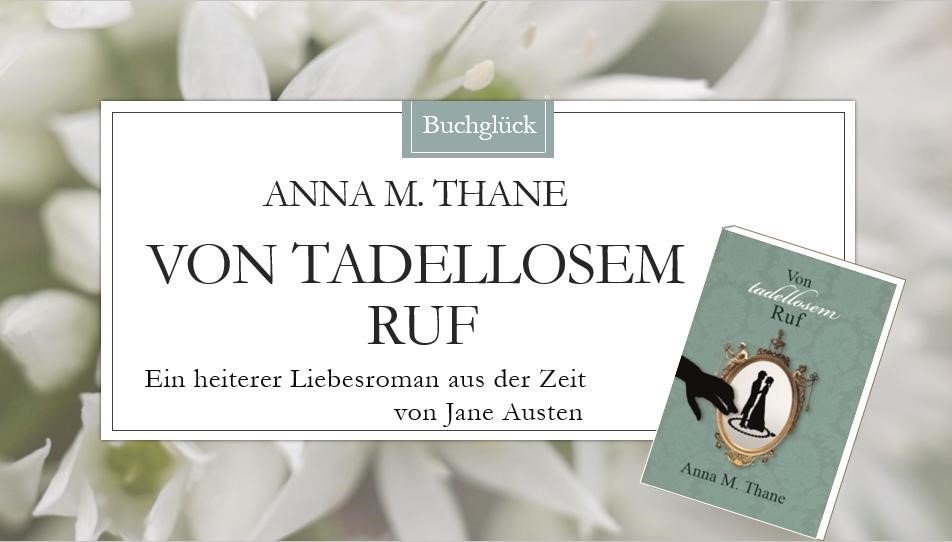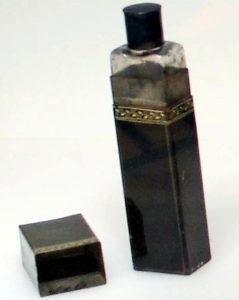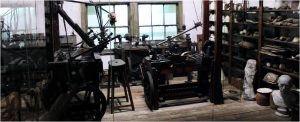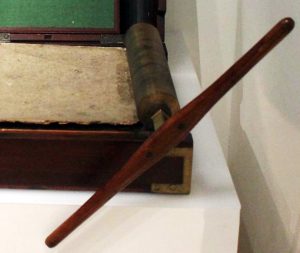 About 250 years ago, science spread into the world and everyday life. People asked how scientific progress and inventions could make life better and easier. They set out to develop and pursue new ideas. Some of these are still around today. In the fourth part of my series, we discover how the invention of a Scottish mechanical engineer changed the office world forever.
About 250 years ago, science spread into the world and everyday life. People asked how scientific progress and inventions could make life better and easier. They set out to develop and pursue new ideas. Some of these are still around today. In the fourth part of my series, we discover how the invention of a Scottish mechanical engineer changed the office world forever.
The Letter Copying Press and Mr Watt’s Secrets Recipes for Ink and Liquor
Important business correspondence had always been copied – by hand. It took until 1780 that the first successful copying machine was patented and made this task easier. The so called letter copying press was even portable, so a businessman could take it along on a business trip. The inventor of this clever piece of efficiency was James ‘Steam Engine’ Watt.
How did it work?
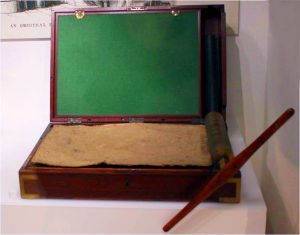 James Watt’s letter copying press basically consisted of two felt-covered boards, a brass roller and a handle. Underneath the writing pad were compartments for pencils, pens, rulers and paper. There also was the damping box which was used for treating the paper as it had to be moist for the copying process.
James Watt’s letter copying press basically consisted of two felt-covered boards, a brass roller and a handle. Underneath the writing pad were compartments for pencils, pens, rulers and paper. There also was the damping box which was used for treating the paper as it had to be moist for the copying process.
The machine copies a written document by pressure onto damp paper, producing a reversed copy from the back. Thus, the paper had to be very thin or even translucent, so that you could read the handwriting the right way round on the “verso” side. The copy was ready for use after 24 hours in a drying book made of absorbent paper.
For the copying process, you needed a special ink that dried slowly and thus allowed for up to 20 copies to be made. Mr Watt also advised to use a special liquid to moisten the copy paper. The recipes for the ink and the moistening liquor were a well kept secret (we come back to this in a minute).
When did the machine hit the market?
James Watt had his new copying method patented in 1780, and soon his company James Watt & Co sold the machine to a variety of customers, among them Benjamin Franklin, Thomas Wedgwood, William Goodwin, Joseph Priestley and Thomas Jefferson. The letter copying press was a huge success: 630 machines were sold during the first year after its market release. The chief distributor was James Woodmason, a stationer in Leadenhall Street, London.
What did it cost?
The letter copying press was sold for is £6/6s in 1780, the copy paper cost 18s per ream (a ream of paper was 480 sheets). While it was possible to buy ink ready to use, there also was special copying ink powder as a reserve. The powder was 18s per dozen vessels. Additional equipment included a box to store the paper so that it could be kept damp and ready for use. The box was sold for 15s.
What was the consequence?
The letter copying press allowed to duplicate letters often in a very short time. Thus, the machine changed the job of a copy clerk in an office from penman to machine operator. It also reduced job opportunities for copy clerks and the skill level required in this position. The machine was used in offices until the early 20th century. An office without a copy machine is unthinkable today.
The secret recipes
As a true Regency Enthusiast, you certainly would like to try a hand at recreating the mysterious ink and liquor used with the letter copying press. I managed to find the original recipes. If you give it a try, please tell me about your experiences.
To create the ink for the letter copying press, you need
- four quarts (ale measure) of spring water,
- one pound and a half avoirdupois weight of Aleppo galls,
- half a pound of green copperas or green vitriol,
- half a pound of gum-arabic and
- four ounces of roach-alum (also known as rock alum or Roman alum; it was alum prepared from the alum-stone in Italy).
Pound the solid ingredients and infuse them in water for 6-8 weeks, during which the liquor should be frequently shaken. Strain the liquor through a linen cloth and keep in bottles, closely corked, for use.
I suppose roach-alum is the important ingredient in the otherwise regular recipe for ink. The stone’s properties have been known since ancient times as softening, moisturizing, astringent, cauterizing, anti-bacterial, and non-allergenic. Some contemporary sources claim that copying ink can be made by adding sugar to regular ink, but Watt, having tried this writes: The problem with sugar, is that it “thickens the ink and causes diffusion in the Copy[,] besides that if much is added, the ink almost who(l)ly leaves the original”.
The liquor for moistening the paper is made as follows:
- Dissolve one ounce of the salt of borax in 2 pounds weight of distilled vinegar.
- Add four ounces of oyster shells calcined to whiteness and freed from their brown crust.
- Shake the mixture frequently for 24 hours.
- Then, let it stand until it deposits its sediment.
- Filter the clear part through unsized paper into a glass vessel.
- Add best blue Aleppo galls, bruised.
Place the liquor in a warm place and shake it frequently for 24 hours. Filter the liquor again through unsized paper in a glass vessel. Add one quart (ale measure) of distilled water. Let it stand for 24 hours and then filter it again until it is free of sediments.
From the Origin of Now Series:
- The Man Who Understood Why Airplanes Fly
- Sports Equipment: Roller Skates
- From Mysore with Love: Revolution in Warfare
- Writing Tool: The Steel Pen
- Eat, Cook, Love: Revolution in the Kitchen
- Financial Instrument: Covered Bonds
- The First Modern Hotel
Sources
- Science Museum, Exhibition Rd, London SW7 2DD, UK
- Letter from Benjamin Franklin to James Woodmason, 25 July 1780 http://founders.archives.gov/documents/Franklin/01-33-02-0085
- Letter To Benjamin Franklin from James Woodmason, 8 October 1781 http://founders.archives.gov/documents/Franklin/01-35-02-0435
- To Benjamin Franklin from James Woodmason, 12 September 1780
- http://founders.archives.gov/?q=Author%3A%22Woodmason%2C%20James%22&s=1111311111&r=3
- Letter To Benjamin Franklin from James Woodmason, 1 November 1780
- http://founders.archives.gov/?q=Author%3A%22Woodmason%2C%20James%22&s=1111311111&r=4
- Archer, Caroline: Experiments in reproduction; Tuesday 31 May 2016 at: http://www.printweek.com/print-week/feature/1157514/experiments-in-reproduction,
- Clemit, Pamela: William Godwin’s Wet-Transfer Copies and James Watt’s Copying Machine, 24. June 2014 at: https://objectarchives.wordpress.com/2014/06/24/william-godwins-wet-transfer-copies-and-james-watts-copying-machine/
- Rudder, Debbie: James Watt letter copying press, 1780 – 1830; The Powerhouse Museum 500 Harris Street, Ultimo, NSW, 2007, Australia; article at: http://www.powerhousemuseum.com/collection/database/?irn=66003
- https://new.liveauctioneers.com/item/17377364
- http://founders.archives.gov/documents/Franklin/01-35-02-0189
- James Watt & Co.: Directions for using the Patent Portable Copying Machines, invented & made by James Watt and Company, of Soho, near Birmingham; T. A. Pearson’s Printing Office, 1810.
- Specification of the patent granted to Mr. James Watt of Birmingham, for his new method of copying letters and other writings; in: The Repertory of Arts and Manufactures, Vol 1; London, 1794.
Article by Anna M. Thane, author of the novel
“Von tadellosem Ruf” (http://amzn.to/2TXvrez)
